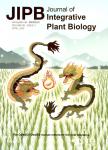Physiological and Molecular Features of the Pathosystem Arabidopsis thaliana L.-Sclerotinia sclerotiorum Libert
Physiological and Molecular Features of the Pathosystem Arabidopsis thaliana L.-Sclerotinia sclerotiorum Libert作者机构:College of Agriculture and Biotechnology Zhejiang University Hangzhou 310029 China Institute of Plant Physiology and Ecology Shanghai Institutes for Biological Sciences the Chinese Academy of Sciences Shanghai 200032 China Institute of Plant Pathology Georg-August University Goettingen Goettingen 37077 Germany
出 版 物:《Journal of Integrative Plant Biology》 (植物学报(英文版))
年 卷 期:2006年第48卷第1期
页 面:44-52页
核心收录:
学科分类:0710[理学-生物学] 1007[医学-药学(可授医学、理学学位)] 100705[医学-微生物与生化药学] 07[理学] 071005[理学-微生物学] 10[医学]
主 题:Arabidopsis defense pathogenesis pathosystem Sclerotinia sclerotiorum.
摘 要:The fungal pathogen Sclerotinia sclerotiorum Libert causes rot diseases on many crops worldwide and large economic losses occur frequently because of a lack of resistant varieties. The pathogenesis of S. sclerotiorum and the molecular basis of plant responses to the pathogen are poorly understood. In the present investigation, the process of S. sclerotiorum infection in Arabidopsis thaliana L., a plant that is highly susceptible to this fungus, was analysed. In addition, the defense activation in the host was investigated. A convenient inoculation method using millet grain was developed for S. sclerotiorum in Arabidopsis. The fungus rapidly infected the plants, probably through ball- or cushion-like infection structures. Visible symptoms developed within 24 h and plants were killed 72 h after inoculation. Cellulase, the main enzyme that caused host tissues to rot, was secreted by S. sclerotiorum in a pH-dependent manner. Oxalic acid, another pathogenic factor secreted by the fungus, induced necrotic lesions on the leaves, infection with S. sclerotiorum strongly induced the production of the pathogenesis-related (PR) proteins β-1,3-glucanase and chitinase in Arabidopsis. Furthermore, the PR gene PDF. 1 was induced, but not PR1, indicating that the pathogen activated basal defense of jasmonic acid/ethylene dependence, which is consistent with its necrotrophic characteristics. This pathosystem for Arabidopsis-S. sclerotiorum could provide an approach for the analysis of the interactions between S. sclerotiorum and other crops, thereby facilitating genetic manipulation techniques for controlling this pathogen.



